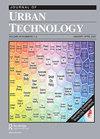diy街景和谷歌街景的城市想象
IF 4.6
3区 经济学
Q1 URBAN STUDIES
引用次数: 6
摘要
谷歌街景(Google Street View, GSV)是大多数情况下街景视觉呈现的实际平台;然而,由于一系列政治、法律、技术和经济因素,其覆盖范围极不平衡。GSV的时空差异在城市中最为明显,这推动了一种扭曲的城市想象,即缺失、碎片和过时。本文追踪了360°成像的关键发展,包括新的参与者、平台、技术和数据生产方法,这些发展有望扩大街道级图像的生产和消费。然后,结合消费级成像技术和DIY城市主义的概念,本文开发了一种DIY街景方法,作为一种生成街道级图像的新模式。根据一项试点研究的结果,本文考虑了街景制作的关键实际问题,与企业和众包图像计划相关的DIY方法的收益和风险,以及360°城市代表性的政治。研究结果表明,DIY的方法为360°街道层面的空间呈现提供了更“精心策划”的潜力;然而,这“第三条道路”有一些特殊的考虑需要进一步注意。本文章由计算机程序翻译,如有差异,请以英文原文为准。
Do-It-Yourself Street Views and the Urban Imaginary of Google Street View
ABSTRACT Google Street View (GSV) is the de facto platform for street-level visual representation in most settings; however, its coverage is highly uneven due to a range of political, legal, technological, and economic factors. GSV’s spatiotemporal disparities are most evident within cities, and this advances a distorted urban imaginary of absences, fragments, and obsolescences. This paper traces key developments in 360° imaging poised to expand the production and consumption of street-level imagery, including new actors, platforms, technologies, and data production approaches. Then, engaging with consumer-grade imaging technologies and the notion of do-it-yourself urbanism, this paper develops a DIY street view approach as one new mode of producing street-level imagery. Drawing on the findings of a pilot study, the paper considers key practical issues for street-view production, the benefits and risks of DIY approaches in relation to corporate and crowdsourced imagery initiatives, and the politics of urban representation in 360°. Findings suggest that the DIY approach offers the potential for a more “careful curation” of space in 360° street-level representations; however, there are considerations specific to this “third way” that require further attention.
求助全文
通过发布文献求助,成功后即可免费获取论文全文。
去求助
来源期刊

Journal of Urban Technology
URBAN STUDIES-
CiteScore
8.50
自引率
4.20%
发文量
42
期刊介绍:
The Journal of Urban Technology publishes articles that review and analyze developments in urban technologies as well as articles that study the history and the political, economic, environmental, social, esthetic, and ethical effects of those technologies. The goal of the journal is, through education and discussion, to maximize the positive and minimize the adverse effects of technology on cities. The journal"s mission is to open a conversation between specialists and non-specialists (or among practitioners of different specialities) and is designed for both scholars and a general audience whose businesses, occupations, professions, or studies require that they become aware of the effects of new technologies on urban environments.
 求助内容:
求助内容: 应助结果提醒方式:
应助结果提醒方式:


